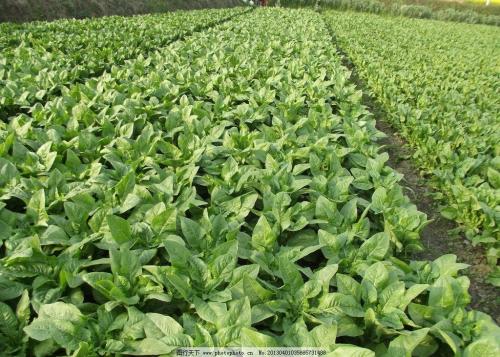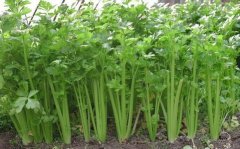How to grow lettuce: When to grow lettuce, lettuce cultivation requirements for the environment
Cultivation and management of leaf lettuce
Lettuce is a very popular vegetable, and the morphological and color changes of cultivated varieties are quite rich. according to the morphology, the common cultivated varieties are divided into leaf use, leaf peeling, standing leaf, wrinkled leaf, heading and tender stem. Leaf lettuce, standing leaf lettuce and wrinkled leaf lettuce are also known as non-heading lettuce. The colors are green and purple, and green is divided into light green, yellowish green and dark green; purple also has different changes such as lavender and dark purple; others have purple-green mosaic and other colors.
The local variety of non-heading lettuce (leaf lettuce) is accustomed to fried food, raw food with a bitter taste. Lettuce with standing leaves and wrinkled leaves are more often eaten raw. At present, most of the common raw food varieties are introduced from Japan, Europe and the United States, and it is a very popular lettuce salad.
The juice of lettuce stems and leaves is milky white, contains lettuce element (Inulin), tastes bitter, the producer is bitter in high temperature period, and the quality is better in low temperature period. In addition, there are also varieties that do not taste bitter, such as the Dahu 659 semi-heading variety, which is not bitter, but its leaf balls are not easy to bear balls in the summer high temperature period.
I. Variety characteristics:
1. Leaf varieties:
Leaf varieties are very common local varieties in Taiwan. the leaves are scattered and do not bear balls, and the leaves are thin, which are commonly called leaf lettuce. The main edible parts are tender leaves, and it is customary to harvest the whole plant. Because of its wide adaptability to climate and soil, tolerance to diseases and insect pests, easy cultivation and short growth period, the number of growth days is about 25-50 days according to the temperature, which can be cultivated in Taiwan every year. Mainly stir-fried food, raw food with a bitter taste. According to the leaf type, the common local varieties are divided into round leaves and pointed leaves, round leaf varieties are cyan, yellow, and white, and sharp leaf varieties are large pointed and small sharp.
two。 Leaf stripping varieties:
Leaf stripping varieties are local varieties, which are grown and eaten with mature young leaves, so the longer the plant is, the taller the plant is. The common leaf types are pointed leaves and split leaves, and the colors are green and purple-green mosaic. Because its stem and leaf juice is milky white, bitter and contains Inulin, it is not common. But a group of non-bitter varieties, also known locally as sugar beets, are becoming more and more popular with consumers.
3. Standing leaf varieties:
The standing leaf variety has erect leaves, thick leaves, generally non-heading or cylinder-shaped, which is very similar to the local round-leaf green lettuce variety at first glance. At present, most of the cultivated varieties are introduced from Japan or Europe and America, and the suitable cultivation period in this province is 10-3 months. The main food is raw food, and the main edible part is tender leaves.
4. Wrinkled leaf varieties:
The leaf of wrinkled leaf variety is deeply split, the leaf surface is shrunken, the leaf is thin, the leaf shape is open and scattered, and does not bear balls. The colors are green and purple. The main food is raw food, and the main edible part is tender leaves, commonly known as lettuce. Because of its rich color and split leaf shape and beautiful appearance, it is very popular with consumers. The suitable period for cultivation in this province is 10-3 months. When cultivated in high temperature period, its stems and leaves have a strong bitter taste.
5. Heading varieties:
The growth period of the variety with round or oblate leaf ball and compact leaf ball is about 3.5 months, and the growth period of the variety with non-tight leaf ball is about 2.5 months. There are two kinds of foliar wrinkles and smooth leaves. The suitable period for cultivation in this province is 10-3 months. No ball during the high temperature period. A large temperature difference between day and night is conducive to ball formation. The proper temperature for pilling is 17-18. C, 21 . The leaf ball above C is not easy to form.
6. Tender stem varieties:
There are two types of leaves: pointed leaves, round leaves, green, dark green and purple-red leaves. Smooth or wrinkled, margin entire or notched. The stem is hypertrophy, the color of stem epidermis is green, light green and purplish red, and the color of stem meat is wired and light green. White stem and green stem. The suitable cultivation period in this province is 10-3 households. Large temperature difference between day and night is beneficial to stem hypertrophy.
Second, seed characteristics:
The optimum temperature for lettuce seed germination is 15-20. C, poor germination in high temperature environment, easy to enter dormancy, 30. The germination above C was blocked.
After soaking the seeds, dormancy will be broken at low temperatures. The seeds were immersed in flowing water for 10-12 hours and at a low temperature of 4-6. Under C, dormancy will be broken in about 3-5 days. Seeds can still germinate in high temperature after breaking dormancy, but they will also enter dormancy if they are soaked without low temperature. Fresh seeds are more sensitive to high temperature than mature seeds. Seeds that break dormancy are sown in the shade before the radicle breaks through the seed coat. Seeds that break dormancy should not be rubbed by gravity, otherwise the endosperm and roots will lose their ability to germinate due to mechanical injury.

Third, the appropriate temperature for childbearing:
Lettuce is a temperature-sensitive vegetable, which can induce flower bud differentiation by high temperature induction at appropriate seedling age, and promote bolting and flowering by warm and long days. The optimum temperature for childbearing is 12-20. C,24 . The growth is exuberant at C, 24. It is easy for small plants to bolt when C is above. The variety of heading is 21. When the temperature is above C, the leaf ball is not easy to form, and the high temperature can easily cause the necrosis and decay of the heart leaf tissue.
Leaf lettuce is a cool crop. Taiwan autumn, winter and spring are the suitable time for cultivation. Leaf lettuce of the two local varieties can be cultivated all year round, but it is easy to bolt in high temperature period. The heading and tender stem varieties are not suitable for cultivation in the high temperature period, the leaf balls of the heading varieties in the high temperature period are not easy to form, and the stems of the tender stem varieties are not easy to enlarge. The varieties of standing leaves and wrinkled leaves are easy to bolt at high temperature and have a strong bitter taste.
4. Soil conditions:
Although lettuce has a wide adaptability to the soil, but because its root group is small and only distributed in the topsoil layer, it is best to have good drainage and fertile organic sandy loam, and pay attention to keep the soil moist during the growth period. The pH value is 5. 5-6. 5.
5. Cultivation and management methods of non-heading lettuce:
1.
Seed preparation: it is difficult for non-heading lettuce seeds to germinate in high temperature environment, and it is easy to enter dormancy. Pre-treatment such as soaking seeds and low temperature before sowing can successfully break dormancy and promote germination rate. Lettuce is a simple pre-treatment method, soaking the seeds in flowing water for about 10-12 hours and keeping the seeds moisturized at 4-6. C ice storage for 3-5 days, that is, break dormancy, take out and put the seeds in a cool place to dry and sow. Seeds that have broken dormancy must be sown immediately so that rabbits lose their ability to germinate.
two。
Sowing: the growth period of non-heading lettuce is about 25-50 days, and direct seeding is used in traditional cultivation methods. However, due to the small seeds of lettuce, the sowing density is not easy to control, so the traditional direct seeding method is simple and easy, but because the sowing density is uneven, it is necessary to carry out inter-pullout work in the early growth stage to increase labor. In the field with more weeds, weeding must be carried out at least once during the growth period, otherwise the growth will be hindered. At present, hand-held seeder can be used to assist sowing to improve the problem of uneven sowing density and reduce the work of pullout. By using the method of seedling transplantation, the work of inter-pulling and weeding can be reduced, but the work of raising seedlings and transplanting can be increased, but it can make the products neat and beautiful, and improve product quality, output and output value. Therefore, it is suggested that the method of seedling transplanting can be used in the fields with more weeds.
3.
The method of transplanting seedlings on the acupoint plate: the seedlings can be raised by using 288 cubicles. The seedling age of this leaf is 3-4 months and the root system is well developed, so it can be transplanted to the field.
Note:
(1)
The budding place must be cool, avoid direct rabbit sunlight, and preferably have a budding room. During the period of germination, the medium must be kept humid, otherwise the seed will lose its germination ability due to water loss.
(2)
When the germination is completed, the primary roots of the seeds are prominent, that is, they are moved to the nursery for management, and the cotyledons can not be unearthed and then moved to the nursery, otherwise they will form weak seedlings and die in serious cases.
(3)
The row spacing of local lettuce varieties and standing leaf varieties was 15X15 cm, and that of wrinkled leaf varieties 20X20 cm.
- Prev

Introduction to cauliflower: what are the varieties of cauliflower, the efficacy and function of broccoli
Blue and white moss is a perennial perennial herb of Brassica in Cruciferae. Because the edible part is mainly composed of dense buds, it is called blue and white moss. Native to the coastal areas of Western Europe, it is a variety of wild cabbage. Its cultivation history is earlier than that of cauliflower.
- Next

Cultivation methods, cultivation and planting techniques of celery
Celery organic cultivation variety celery petiole slender hollow, strong flavor, can be used for stir-frying, cooking and spices. Varieties can be divided into local species: field tail species (green leaves and white bones), green tube, summer celery; western species (green and yellow). The petiole of the field tail species is light green, less fibrous and divided.
Related
- A one-day flower show brings 130 million yuan in orders! Nanhai, this Phalaenopsis exhibition is amazing
- What do the flower language and meaning of Lutheran tree mean? Precautions for planting Lutheran tree
- Encounter Chaoshan Kongfu tea, not without this cup of Phoenix single clump
- The durian market in Vietnam and Thailand is flooded. The price of imported durian has plummeted by 30-40% in a month.
- Shanghai solved the problem of local vegetable supply by planting 80,000 mu of green leafy vegetables.
- Wageningen University has become the best agricultural university in the world for the seventh time in a row.
- The strongest export season of South African grapes is full of challenges, with exports to Russia falling sharply by 21%.
- Sri Lanka is on the verge of bankruptcy, "Tea for debt" Organic Agriculture Revolution aggravates the Food crisis?
- Turning waste into earthworm manure and worm manure into organic fertilizer-A new choice for auxiliary farming
- Organic rice growers shoulder the responsibility of nurturing agricultural talents! Yinchuan Sustainable Farm with Organic Life Camp

